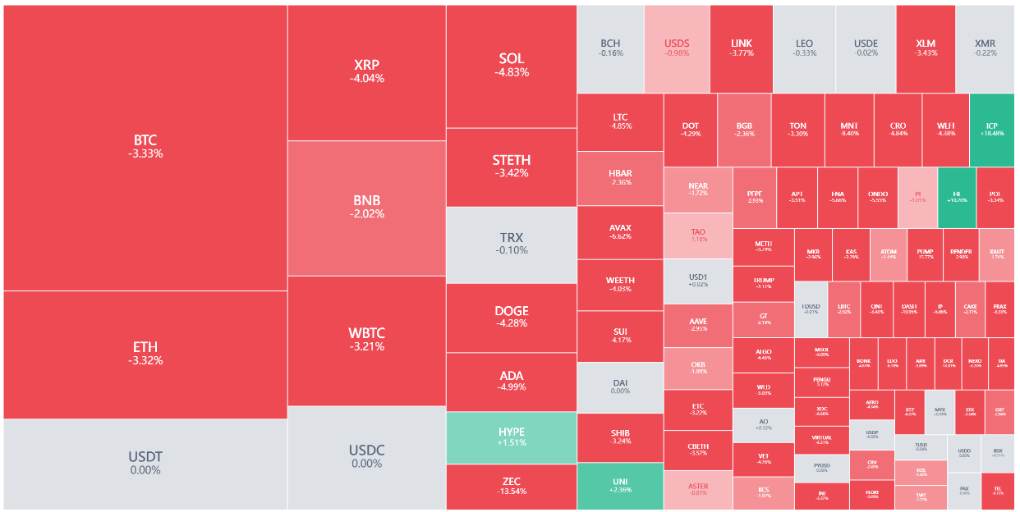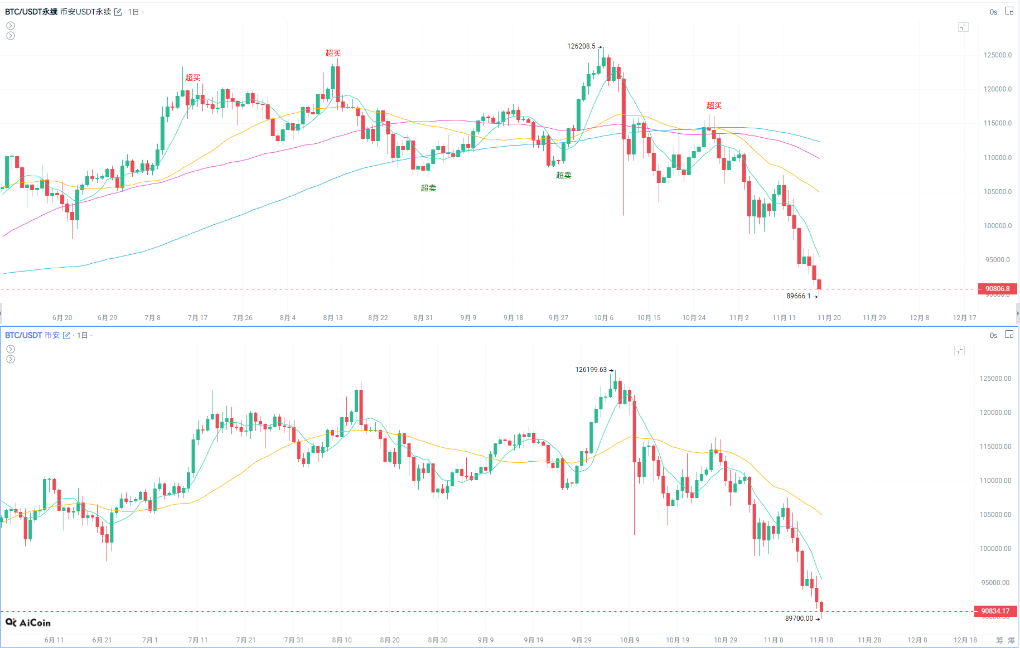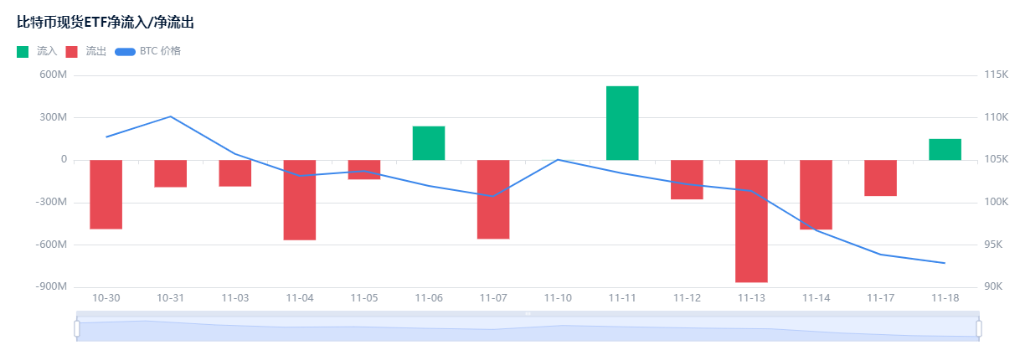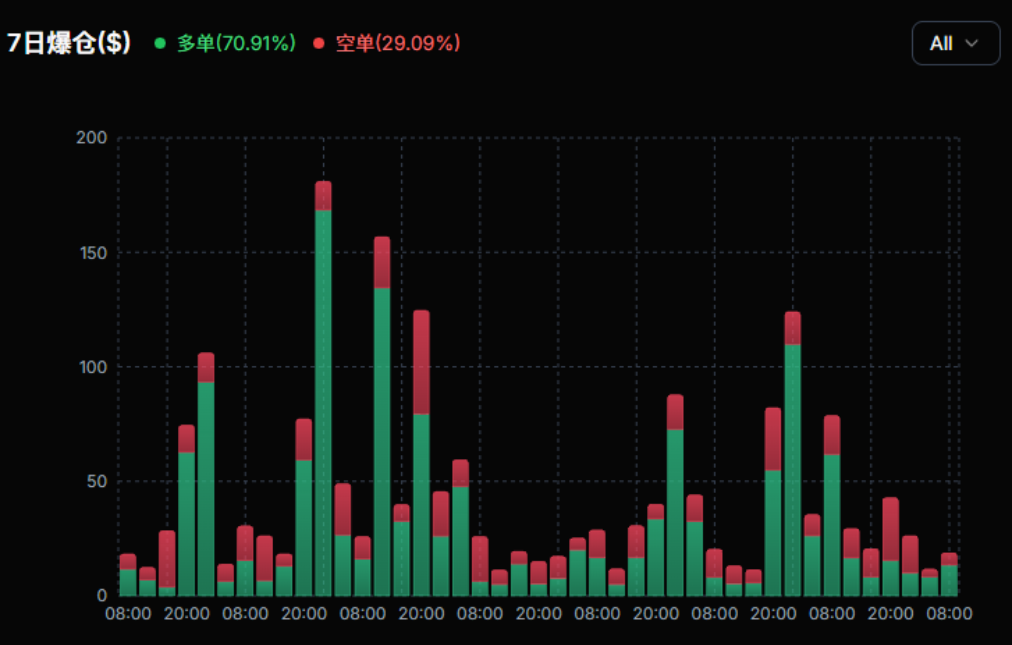Digital gold has lost its luster, and the cryptocurrency market is struggling to move forward in a quagmire of panic. "Bitcoin has fallen below $90,000!" This news hit the market like a bomb, leaving investors staring in shock at the red candlesticks on their screens.
On November 18, 2025, Bitcoin briefly dropped to $89,253, marking a seven-month low and a decline of over 27% from last October's historical high.
The cryptocurrency fear and greed index has plummeted to 16, entering the "extreme fear" zone, with some data even showing the index dropping further to 13. Market sentiment has cooled to freezing point, and investors are preparing for Bitcoin to potentially fall further to $85,000 or even $80,000.

1. Market Status: Free-Fall Decline
Bitcoin is experiencing a free-fall decline. As of November 18, the price of Bitcoin has fallen below the $90,000 mark, hitting a low of $89,253. This price indicates that Bitcoin has erased all gains made in 2025, down over 27% from last October's historical high.
● Bitcoin's weak performance has quickly infected the entire cryptocurrency market. Ethereum, as the second-largest cryptocurrency, is also struggling, dropping to $2,950, down 2.6% in a single day. Since early October, Ethereum has declined by about 24%, showing even weaker performance.
● During the Asian trading session, the selling pressure in the cryptocurrency market was particularly evident. On the morning of November 18, Hong Kong time, Bitcoin fell over 3%, and market panic continued to spread.
● The entire cryptocurrency ecosystem is feeling the chill. Stocks of cryptocurrency hoarders, mining companies, and exchanges like Coinbase have all declined as market sentiment worsens.

2. Options Market: Traders Prepare for Greater Declines
In the face of the ongoing market decline, options traders are preparing for further drops in Bitcoin.
● The demand for downside protection has surged, with the volume of put contracts significantly exceeding that of call options.
● AiCoin data shows that traders' protective demand for Bitcoin falling to $90,000, $85,000, and $80,000 has skyrocketed. Reports indicate that the volume of put contracts expiring at the end of November has exceeded $740 million.

● The put/call ratio, a key options market indicator, provides further evidence. Although some data shows that the Bitcoin options put/call ratio has dropped to 0.5, indicating market optimism, the current market environment has changed significantly.
● Matthew Dibb, Chief Investment Officer of Astronaut Capital, stated: "The next support level is $75,000, and if market volatility remains high, it could reach this level."
3. Derivatives Signals: Significant Drop in Open Interest
The derivatives market is sending clearer bearish signals. The total open interest in Bitcoin futures across the network has dropped by about 30% from the peak on October 7.
● The decline in open interest indicates that the overall interest, liquidity, and speculative intensity of market participants are weakening, which typically leads to reduced market volatility. This data sharply contrasts with the early trend when the total open interest in the 2025 cryptocurrency derivatives market first surpassed $50 billion.
● The cooling of the derivatives market suggests that market momentum is weakening. ChainCatcher reports confirm that the current open interest in Bitcoin futures across the network is 737,540 BTC (approximately $66.54 billion), far below the peak of $94.12 billion on October 7.
This decline coincides with a broader deleveraging process in the cryptocurrency market.
4. Causes of the Decline: Multiple Factors Suppressing the Market
Macroeconomic Pressures and Federal Reserve Policies
● Broader market forces are suppressing sentiment in the cryptocurrency market. Market participants point to skepticism about future interest rate cuts in the U.S. and the sentiment in the broader market dragging down cryptocurrencies.
● “Discussions about the Federal Reserve and the AI bubble are the two main resistances facing risk assets before the end of the year,” said Kaiko analyst Adam McCarthy. Expectations for a rate cut by the Federal Reserve in December have weakened. According to data from the Chicago Mercantile Exchange (CME), only about 44% of traders predict a rate cut in December.
● Federal Reserve officials, including Chairman Jerome Powell, have expressed reluctance to further ease policies, leaving investors uncertain about the central bank's next steps.
Data Delays and Market Uncertainty
● Data gaps are exacerbating market uncertainty. Due to recent U.S. government shutdowns causing weeks of data delays, policymakers still lack sufficient data. These delayed data are expected to start being released this week, with the non-farm payroll report scheduled for Thursday.

● The market's reaction to this data may determine the short-term trajectory of cryptocurrencies.
Slowing ETF Inflows
● The slowdown in Bitcoin ETF inflows is also a reason for the decline. As volatility rises, institutional buyers have retreated, leading to weakened inflows into spot Bitcoin exchange-traded funds. These ETFs have played a significant role in driving up Bitcoin prices, but their influence is waning.

Liquidation Waves and Deleveraging
● The market has been in turmoil since experiencing a severe wave of liquidations in early October, when approximately $19 billion in cryptocurrency positions were wiped out. “The sentiment has been very low since the leveraged washout in October,” said Matthew Dibb, Chief Investment Officer of Astronaut Capital.

The financial pressure faced by cryptocurrency lending companies, mining firms, and other native cryptocurrency entities has intensified these concerns.
5. Market Panic: Chain Reactions and Institutional Dilemmas
Cryptocurrency Treasury Companies Under Pressure
● Digital asset "treasury companies" are under immense strain. These companies hoarded large amounts of cryptocurrency earlier this year, attempting to become concept stocks in the cryptocurrency accumulation space.
● Although Michael Saylor's MicroStrategy recently purchased $835 million worth of Bitcoin, many of his peers are facing increasing pressure to sell assets to protect their balance sheets.

● Greg Magadini, Director of Derivatives at Amberdata, stated that this sell-off has created a vicious cycle, noting: “Ethereum is very susceptible to this trend because the largest digital asset treasury companies are currently in a loss position.”
Market Panic Spreading
● Market panic is not limited to Bitcoin. The world's second-largest cryptocurrency, Ethereum, has dropped to $2,975, down 24% since early October, showing particularly weak performance.
● Chris Newhouse, Research Director at Ergonia, focused on decentralized finance, stated: “As buyers who accumulated positions over the past six months find themselves severely trapped, the demand for bullish positions based on conviction is becoming increasingly weak.”
● Cryptocurrency participants are in a state of "extreme fear." The market is filled with investors who are too deep in losses to continue buying but are unwilling to cut their losses.
6. A Glimmer of Hope in the Darkness
Pessimistic Expectations
Market analysts are pessimistic about Bitcoin's short-term trajectory. Many analysts predict that Bitcoin will further decline to the $86,000 level.
● Technical analysis shows that Bitcoin failed to hold the support level near $94,000, triggering a "death cross" signal between the short-term and long-term moving averages.
● Nuc Puckrin, founder of CoinBureau, pointed out that although a 25% drop is the lowest adjustment level in this cycle, compared to previous drops of over 30%, investor sentiment is still collapsing.
Long-Term Positive Factors
● Despite the overall pessimism in the market, there are still voices maintaining confidence in the long-term prospects of cryptocurrencies. Hunter Horsley, CEO of Bitwise, stated that despite the market crash, the long-term fundamentals of cryptocurrencies have "never been stronger."
● Horsley believes that the four-year market cycle has died out, replaced by a more mature market structure and changing market dynamics due to the U.S. regulatory shift towards supporting cryptocurrencies.
● Thomas Perfumo, Head of Strategy at Kraken, expects that by 2025, the inflow of cryptocurrency ETFs will double to $50 billion. He believes that ultimate allocation institutions such as sovereign wealth funds, endowment funds, and pension funds will gradually enter the market next year.
Lessons from Historical Patterns
● Historical data suggests that the current market panic may be setting the stage for a future rebound. According to the historical patterns of the Crypto Fear & Greed Index, when the index falls into the "extreme fear" zone (below 20), it often coincides with significant market bottoms.
● These lows include July 2021, June 2022, December 2022, August 2024, and March 2025. Current market sentiment is approaching these historical low levels, suggesting that a short-term bottom may be forming.
On the technical charts, Bitcoin's next key support level is at $75,000, and if market volatility remains high, it may test this position. However, if strong support is found at this level, the market may enter a new upward trend.
Markets are always reborn in despair and end in celebration. Today's panic may be sowing the seeds for tomorrow's recovery.
Join our community to discuss and grow stronger together!
Official Telegram community: https://t.me/aicoincn
AiCoin Chinese Twitter: https://x.com/AiCoinzh
OKX benefits group: https://aicoin.com/link/chat?cid=l61eM4owQ
Binance benefits group: https://aicoin.com/link/chat?cid=ynr7d1P6Z
免责声明:本文章仅代表作者个人观点,不代表本平台的立场和观点。本文章仅供信息分享,不构成对任何人的任何投资建议。用户与作者之间的任何争议,与本平台无关。如网页中刊载的文章或图片涉及侵权,请提供相关的权利证明和身份证明发送邮件到support@aicoin.com,本平台相关工作人员将会进行核查。




